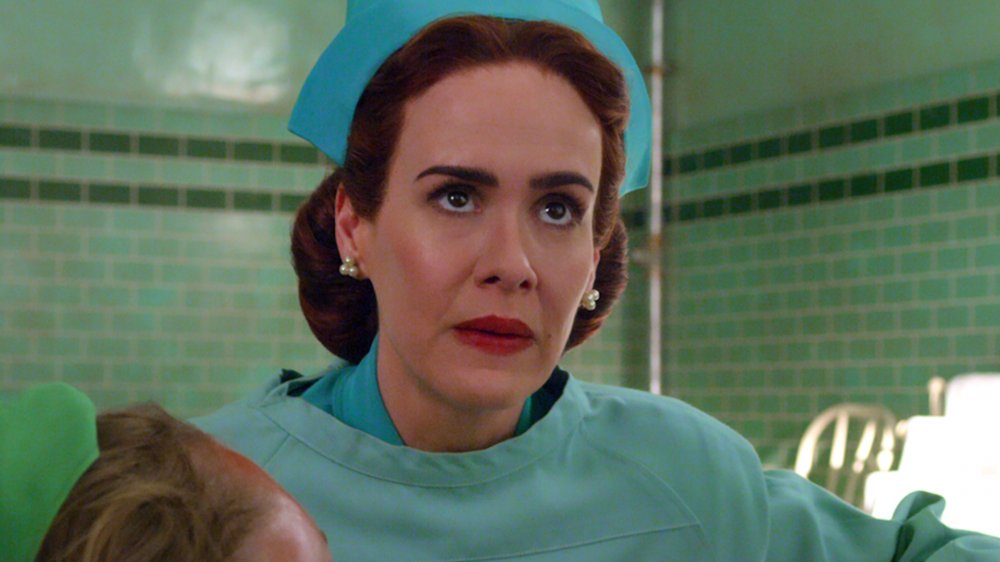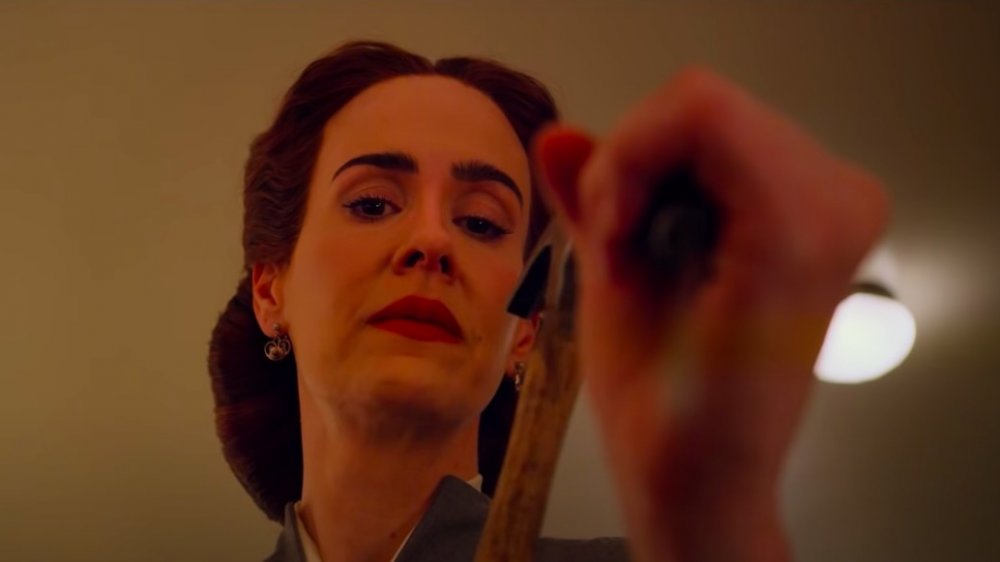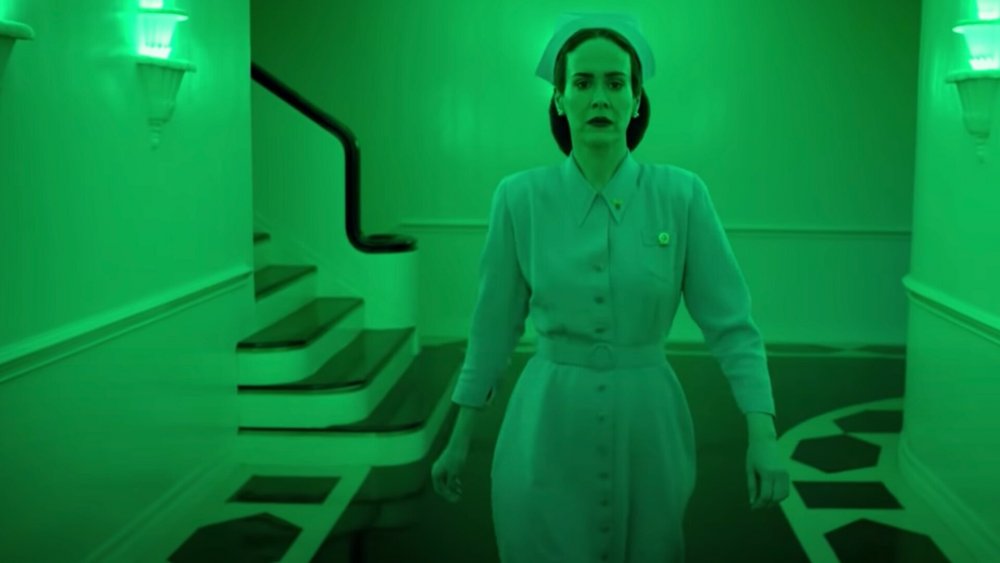How Sarah Paulson Made Nurse Ratched Her Own
Between characters like Walter White and Norman Bates, TV enthusiasts are fascinated with the dark edges of characters who hurt other people in their warped pursuit of doing the right (wrong) thing until they become straight-up villains. Ken Kesey's 1962 novel One Flew Over the Cuckoo's Nest and Louise Fletcher's portrayal of Nurse Mildred Ratched in the 1975 film adaptation of the book portrays the dastardly nurse as a bonafide villain — and one of the most insidious ones in cinematic history at that.
But how did she get there? What happened to the heartless nurse before she started giving out lobotomies like candy? What turned her into the hardened person that she is? There's a strong debate in psychology about nature versus nurture – whether people are simply programmed a certain way, born bad or good or indifferent, or if they're more shaped by their environment than they are their DNA. Could Ratched's path to darkness have been prevented, or was it inevitable that she become a homicidal, soulless caretaker who takes from her patients more than she cares for them?
Netflix's upcoming Ryan Murphy series Ratched gives us a window into the life of Mildred Ratched. Looper recently participated in a press conference for Ratched, during which actress Sarah Paulson gave us the inside scoop on just how Nurse Ratched became so wretched.
Carving a backstory for cinema's most notorious nurse
When asked what made Paulson say "yes" to Ratched, the American Horror Story actress had a lot to say.
"I think it's safe to say that many people are at least familiar with, if not well-versed in, One Flew Over the Cuckoo's Nest the movie, and Louise Fletcher's performance, and the sort of iconography that was etched and sketched by everybody in that movie," she noted. "And I think she's in the top five AFI [American Film Institute] villains of all time in cinematic history." Paulson then joked, "So it's no pressure, and it's just an opportunity for me to be humiliated. It's not an issue. It's fine."
She went on to reveal, "I think it wouldn't have been interesting to me to explore the parts of Mildred Ratched that aren't porous. And in the movie, she's calcified. There's a hardness. Nothing ekes out. And I remember, when I first saw the movie, thinking years ago that [Ratched] was absolutely a villain and evil and all this stuff."
Given that the original film hones in on Jack Nicholson's character Randle Patrick McMurphy and the rest of the psych hospital patients, Ratched looms in the background as a sinister force. The fear she permeates exists more in the patients' whispers than what viewers watch Ratched do herself, which makes her presence as a villain that much stronger. What nefarious deeds occur behind closed hospital doors when Ratched is in the room? No one seems to be in any shape afterward to say, and that's almost scarier than the deeds themselves. Alternatively, Netflix's Ratched shines a surgical light right on the nurse, filling in some of those blanks.
"When I re-watched [One Flew Over the Cuckoo's Nest] before we started [Ratched], I thought, 'This is a woman who's sort of a victim of a patriarchal infrastructure in this hospital.' [...] It's quite possible, and could it be considered that she didn't have any choice about whether or not she could access her heart in her work? If she could bring her femininity and her womanhood to the job?" Paulson reasoned. "What about considering [the] idea [that] she's not a villain, but she's a person who didn't have any recourse?"
Even a woman as commanding as Ratched wouldn't have much authority with her male superiors (though the nurse was allegedly blackmailing Dr. Spivey in the novel) and certainly holds her own in manipulating patients and higher-ups alike. But even so, how much power does Ratched really have?
The freedom of a blank page
Paulson mirrored that sentiment, saying, "There was nothing [for Ratched] to do. Some people might access that and get fired, and other people think, 'I better toe the line,' and that's sort of what I'm going to do. And the ramifications and the consequences, obviously, were devastating to many of the men in that that were under her care."
While Ratched's deeds aren't excusable even in the Netflix series, it's fascinating to watch the circumstances and biases of the time period affect each character in a significant way.
"I had to believe, if I was going to play it, that she did it because she thought she was adhering to some kind of rule that she believed was most right. Maybe [she was] limited in her thinking because of the era in terms of what she was willing to investigate [and] where she might've found power outside of the confines of that hospital," Paulson continued. "And who knows what her life was like? So I was interested in this idea of who Mildred Ratched [is] when she takes that key and turns it and goes into her house, during that movie. Who is that woman?"
Fans still don't have a crystal-clear picture of exactly who Ratched is by the end of the first season of the show — but that's what the already greenlit second season is for.
"I wasn't thinking of it so much as an opportunity to sort of counteract or have a female Don Draper or someone who was allowed to have those complexities, but it would be impossible to undertake it without thinking, 'We've got to show something here that has yet to be seen.' And it's entirely up to us. We can invent it because there is no backstory," Paulson explained. "That's an enormous freedom, and we can give context and depth to things that maybe weren't there. But it was just interesting to confront my own sort of prejudice against the character from the outset and what I had thought she was."
Fans should also prepare themselves to check all preconceived notions about Nurse Ratched at the hospital doors. As Paulson joked, "Of course, I was looking for a way how I could get in there without being like, 'She is so crazy.' So I don't know if that really answers the question."
Nurse Ratched will be ready to take on new patients when Ratched debuts on Netflix on September 18. Check in at your own risk.


